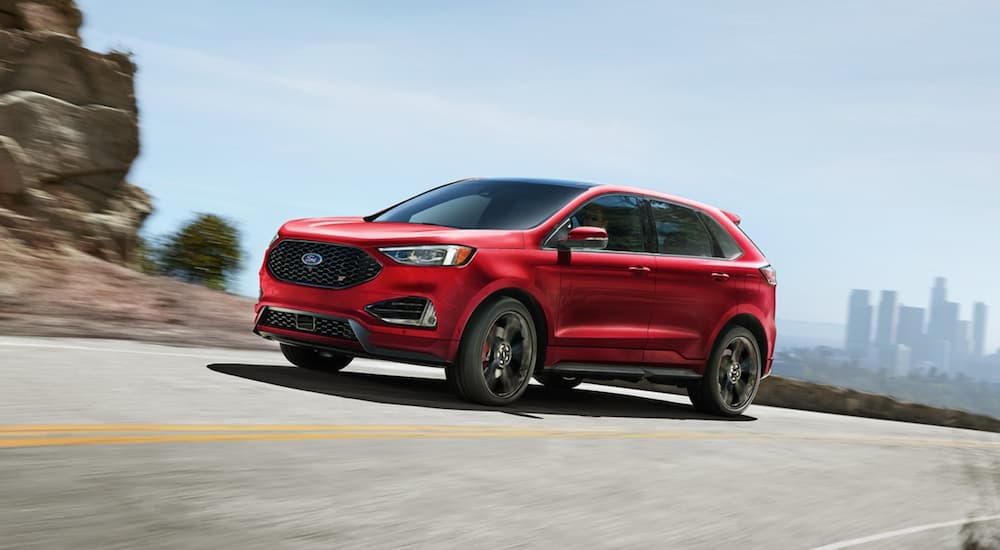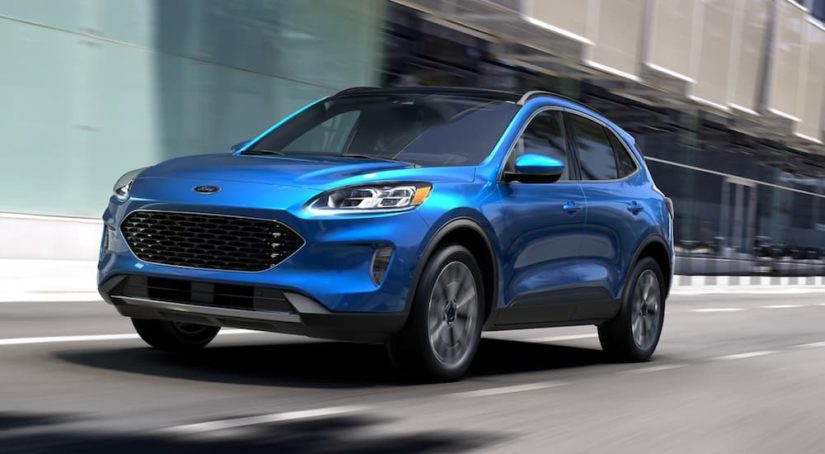Ford has long been at the forefront of vehicle automation, and with some exciting new systems on offer, that doesn’t look to be changing anytime soon. The brand has featured advanced driver-assist technology in many vehicles produced since 2020, meaning that these next-generation features might be more common and affordable than you might think. Before you start searching the web for, “used Ford dealer near me”, read on to learn a little more about some of the exciting automation systems from the storied American brand—and what’s in store for the future when it comes to self-driving vehicles.
The Earliest Automation
The advent of modern cruise control can be traced back to a chatty lawyer in 1948. American automotive engineer Ralph Teetor was riding in the car with his lawyer, who had the annoying habit of either speeding up or slowing down every time he spoke. The incident was as inspiring as it was obnoxious, and Teetor soon got to work on a solution. The first production vehicles with cruise would debut in 1965, but the technology gained widespread adoption in the early 70s as the oil crisis had drivers looking at ways to reduce their gas consumption. Vehicle technology has come a long way in 50 years—with auto manufacturers automating everything from headlights to wipers, but the last few years have seen some considerable progress as the next generation of automation-enabled vehicles starts to hit the streets.
Levels of Automation
The Society of Automotive Engineers (SAE) has developed a classification system that divides automated driving technology into six levels which run from Level 0 (no automation) to Level 6 (full automation). In the bottom half of these levels—Levels 0 to 2—the driver is ultimately responsible for monitoring the roads ahead, whereas the vehicle monitors the driving environment at Levels 3 through 5. At this point, no mass-produced vehicles offer automation above Level 2, but let’s take a closer look at each level to see how far we’ve come and what may be next.

Level 0 – No Driving Automation
At Level 0, a vehicle has only the most basic automated features. The driver is responsible for steering, accelerating, braking and parking, although old-fashioned cruise control can be used to keep a steady speed. These vehicles might include safety features that border on automation, including stability control, forward-collision warning, automatic emergency braking, blind-spot warning, and lane-keeping assistance. These features fall more into the category of alerts than automation and don’t include any technology that actually pilots the vehicle on its own. Most vehicles on the road today would fall under the category of Level 0 automation.
Level 1 – Driver Assistance
Level 1 vehicles feature at least one form of automated driver support to either provide steering assistance or help out with braking and acceleration, but not both. At this level, drivers must still be fully in control of the vehicle and ready to take the wheel if a problem arises. Lane-centering assists—an automated system that helps a vehicle maintain its position in the middle of a lane, would be an example of Level 1 automation. Adaptive cruise control is another good example, giving drivers the ability to set a specific speed and distance from the vehicle ahead and then subtly accelerate or brake to maintain that distance. If a vehicle has more than one of these automated features, it technically qualifies as Level 2 automation instead of Level 1.
Level 2 – Partial Driving Automation
When you start to get multiple automated systems working together for an increasingly hands-free driving experience, you’ve arrived at Level 2 automation. These vehicles feature multiple advanced driving assistance systems (ADAS) that can be used to control steering, acceleration, and braking. These systems are often limited to highway driving, where fewer stops and more consistent speeds make ADAS a more viable option.
In general, these systems still require drivers to keep their attention fully on the road so they can take over at a moment’s notice—should something go wrong, but not all Level 2 automated driving technology is created equal. For example, Highway Driving Assist, the ADAS system found in some Hyundai and Kia vehicles, can only be used when a driver’s hands are on the steering wheel. BlueCruise, Ford’s top-of-the-line ADAS, takes it to the next level by allowing drivers to experience a totally hands-free driving experience. Currently available on over 130,000 roads across North America, BlueCruise is one of the more sophisticated versions of ADAS on the market today.
Level 3 – Conditional Driving Automation
Looking ahead a little bit, Level 3 automation describes systems that can fully automate driving tasks in certain scenarios. Level 3 systems still require the driver to be attentive, alert, and in a position where they can take the wheel if necessary. In general, they’re free to complete other tasks and don’t have to pay attention to the road. Using ADAS and artificial intelligence to achieve what’s known as environmental detection, a Level 3 system can make its own choices about when to change lanes, accelerate, pass a slower-moving vehicle, and brake.
As I mentioned before, no vehicles in the U.S. currently meet the definition of Level 3 driving—but for a glimpse into the future, just take a look at Japan. The island nation is serving as the testing ground for the world’s first Level 3 vehicle, the Honda Legend. While the system currently only works at lower speeds, it’s a promising sign of things to come. Audi and Mercedes-Benz have also come close to rolling out Level 3-enabled models, but regulatory issues have delayed their release.
Level 4 – High Driving Automation
This is where things start to move into the realm of sci-fi. At Level 4, vehicles can operate without any human input, even in an emergency scenario. These systems will—in theory—use advanced radars, GPS mapping, artificial intelligence, and high-definition cameras to monitor everything going on around the vehicle. These features make it perfect for applications like driverless taxis and public transportation.
Level 4 vehicles may not even have a steering wheel or pedals, and most importantly, the “driver” could take a nap while they’re in motion. These systems do have some limitations: They might not be able to operate in extreme weather conditions and will be restricted to mapped streets, highways, and other boundaries—by what’s known as geofencing.
Level 4 automation is currently being tested by several companies, including Google’s Waymo, Magna, Volvo, and Baidu—though none have received approval for use on public roads. Widespread Level 4 automation is still a long way off, but it holds some exciting potential for those of us who love to catch a few ZZZs on the go.
Level 5 – Full Driving Automation
At Level 5 automation, you might not feel like you’re in a vehicle at all. Simply find a seat, set a destination, and find something to occupy your time until you arrive. There will likely be no steering wheel or pedals and the system will do all the thinking for you, even in emergencies. Unlike Level 4 automation, the systems will not be limited by geofencing and will be able to traverse any terrain they encounter, from highways and roundabouts to dirt roads and even off-road environs.
These systems will be able to operate under even the most challenging conditions, including snow or heavy rain, making them even safer than their human-operated counterparts in most situations. While some Level 5 systems are currently being tested, automakers have yet to announce a project that’s anywhere near completion.
SUB
Ford has gotten off to a strong start when it comes to integrating the latest automation technology into its lineup. The automaker currently offers three distinct levels of driver-assist automation technology: Co-Pilot360, Co-Pilot360 Assist+, and the top-tier BlueCruise system. The most basic level, Co-Pilot 360, is available on most Ford and Lincoln vehicles—starting with 2020 models—whereas Co-Pilot360 Assist+ is offered as an optional upgrade. Co-Pilot360 has been named the industry’s third-best Active Driving Assistance System, earning particular marks for its capabilities and performance, and only falling behind luxury brands like Cadillac and Tesla.
BlueCruise is a bit harder to find with the Level 2 hands-free automation tech, being reserved for the higher trims of the F-150 and the new all-electric Mustang Mach-E, but it’s also one of the most advanced on today’s market. Let’s take a close look at each of these systems and delve deeper into the suite of advanced technologies that make life behind the wheel of a Ford easier than ever.
Co-PIlot 360
Co-Pilot360 includes four standard automated safety features and four optional add-ons. These include everything from an advanced blind spot monitoring system known as BLIS (Blind Spot Information System) with cross-traffic alert, which uses radar to detect vehicles that may be hidden from view, activating a small light in the side-view mirror to alert drivers to their presence. Cross-traffic alert serves a similar role, monitoring the area behind the car and alerting drivers to any vehicles that may be passing by as they attempt to back up.
Co-Pilot 360’s lane-keeping system helps to prevent the sort of subtle drifting that can result in dangerous last-minute overcorrections. When the system detects that the vehicle is moving out of the prescribed lane, it can alert the driver using a subtle vibration in the steering wheel. If the driver doesn’t react quickly enough the lane-keeping system can take over steering duties entirely, redirecting the vehicle into the lane and keeping it centered.
Pre-collision assist with automatic emergency braking is another automated safety technology that can make all the difference in the moments before a potential collision. Using a network of cameras, the system can automatically apply the brakes when it detects an oncoming vehicle, obstacles, or even pedestrians in some cases. If a driver doesn’t heed visual and auditory cues, the system can pre-charge the brakes, ramping up their sensitivity so they can more quickly spring into action when you finally do make your way to the brake pedal. If all else fails, the system can apply the brakes on its own.
Lastly, Co-Pilot360 includes auto high-beam headlights. This system not only protects your own vehicle by automatically activating high beams on darker routes, but improves the safety of every other car on the road by dimming the high beams when it detects oncoming traffic.
Co-Pilot360 Assist+
Co-PIlot360 Assist+ adds two important systems to the already generous Co-Pilot360 package. With Co-Pilot360 Assist+, drivers will start to get a taste of true automation with a system that can take over nearly all steering duties in certain scenarios. This differs from the base CoPilot360’s lane-keeping system, which, while it can keep a vehicle centered in the road, is not a truly automated steering system.
With Co-Pilot360 Assist+, Ford vehicles truly start to delve into some Level 1 automation technology, starting with adaptive cruise control. At its most basic, the system allows drivers to set a predetermined speed and choose the distance from any vehicles in their path. This comes in four different levels, ranging from adaptive cruise control with forward collision control and brake support up to what’s known as intelligent adaptive cruise control. While the latter system is only available on a limited number of vehicles, such as the 2020 Ford Explorer, it does represent a significant step up from the basic system with the ability to operate in stop-and-go traffic, keep the vehicle centered in the lane, and adjust speed when it detects changing speed limits.
CoPilot360 Assist+ also features evasive steering assist, which represents a significant step up from the pre-collision assist with automatic emergency braking found on vehicles with Co-Pilot360. Instead of just applying the brakes, evasive steering assist can complement the driver’s own steering inputs, adding a little extra guidance that could make the difference between a close call and a major accident.

Optional Co-Pilot360 Features
Many add-ons can drastically expand the functionality of the Co-Pilot360 suite. Some of these, like pro trailer backup assist and hill descent control, are aimed specifically at SUV and truck drivers—using automation and Ford’s advanced safety technology to take some of the hassle out of trailering and towing. There are also new features that any driver can take advantage of, such as enhanced active park assist. A dream come true for anyone who struggled with the parking portion of their driver’s test, this technology can steer a vehicle into a parallel or reverse perpendicular parking spot with ease. Simply control the acceleration and braking and the system will do all the steering for you. On advanced versions like Active Park 2.0, the system even takes over the braking and acceleration duties, giving drivers nothing to do but sit back and watch the vehicle slide into a spot.
Other add-ons include reverse brake assist, which can bring the vehicle to a stop if it detects an object behind the vehicle while you’re backing up, and the truck/SUV-specific technologies like an advanced version of BLIS that includes trailer coverage. Pro trailer backup assist is another noteworthy addition, taking all the guesswork out of backing up a trailer by allowing drivers to direct the trailer using a small control interface. This takes all that brain-twisting mirror-thinking out of the equation, making for a much smoother trailering experience.
Rounding out the optional features is hill descent control, which gives drivers the ability to set a low, steady speed when descending hills while towing a heavy load. By automatically adjusting the traction control and brake pressure, the vehicle can maintain a constant speed without any of the surprises that can come from navigating down a hill with a heavy trailer.
BlueCruise
BlueCruise is Ford’s most advanced automation system by far. While it’s still limited to a small number of high-end models, BlueCruise marks an important milestone in the development of hands-free driver technology. The system is essentially the culmination of all the advanced safety and driver-assist technologies listed above—plus a little extra, allowing drivers to navigate over 130,000 miles of pre-mapped routes across the U.S. and Canada. Using high-resolution GPS; three radar units mounted on the left, right, and center of the vehicle; and a network of traditional and infrared cameras, BlueCruise represents true Level 2 automation.
The biggest difference between BlueCruise and the standard Co-Pilot360 suite boils down to its hands-free capabilities. The system is so advanced that, when certain conditions are met, the driver can remove their hands from the wheel entirely, activating a hands-free icon and letting BlueCruise take over while they give their shoulders a much-needed rest on longer drivers. Safety is obviously paramount here, and as with all Level 2 automation, drivers still need to pay full attention to the road ahead. Luckily, Ford has built in several fail-safes to ensure that drivers don’t get too comfortable and let their guard down.
Vehicles equipped with BlueCruise feature a small infrared camera mounted on the steering wheel. This is used to monitor the driver’s eyeline, issuing a warning if it detects that their attention is straying from the road. If drivers fail to heed a second warning, BlueCruise will slow the vehicle to a stop if the issue is not corrected. If this happens too often the system will automatically deactivate and cannot be used again until the vehicle is restarted. While this might seem like a bit of an onerous approach from Ford, I appreciate the way it reflects the automaker’s commitment to driver safety.
Between Co-Pilot360, Co-Pilot360 Assist+, and BlueCruise, Ford is all-in on the future of vehicle automation, driver assistance, and safety technology. The systems have already won their fair share of acclaim from industry pros and drivers alike, showcasing their ability to improve safety and convenience with intriguing new technologies that address some of the most stressful and dangerous parts of the driving experience.
From basic features like blind-spot monitoring and adaptive cruise control to exciting new systems like hands-free driving and evasive steering assist, there’s a lot to get excited about when it comes to this technology from Ford. While they still might not be the fully self-driving vehicles we were promised by the sci-fi movies of our youth, they’re getting closer every day—and it’s easy to envision a future in which you step into a “car” that shares few characteristics—steering wheel, pedals, even windows—with the vehicles we know today. There’s no telling what the future may bring, but Ford seems to be all-in on delivering the next generation of driver-assist automation and safety technology to the masses.



